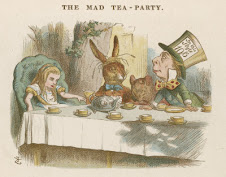The best bet for New Yorkers is to demand an honest mapmaking commission, campaign finance reform, ballot access reform, ethics reform and reforming the house rules.The contradiction involved in all such calls for reform is readily apparent: they would have to be carried by the very same legislators who benefit from the status quo. Conscious of the tension, the editorial thus calls for 'a voters' revolt':
The only sure route to change is through the ballot box — if voters will remember the 2009 fiasco in the 2010 elections. New Yorkers should toss all of these bozos out of office, regardless of whether the incumbent is a Democrat or a Republican, friend or foe. It is the responsibility of both parties to recruit candidates for the primaries to give voters a choice.Such prescriptions reveal the utter bankruptcy of the duopolist mentality. The Times editorial board would have the people of New York call up the arsonists to put out the fire, and call it a 'revolt' no less. Kimberly Wilder, on the other hand, is on the right track when she writes that New Yorkers should be "recruiting independent or third party candidates for the Albany legislative races (Assembly and State Senate — might as well fix it all while we are at it)." Simply trading a Democrat for a Republican or vice versa will do nothing to address the problem in New York's state legislature, the root of which is the duopoly system of government itself.
The political deadlock in New York is but one instance of a nationwide phenomenon. In an Op-Ed for the New York Times in April, entitled 'No Country for Close Calls,' Nate Silver and Andrew Gelman of FiveThirtyEight noted that competitive elections for the House of Representatives are "exceedingly rare." They wrote:
In the past decade, there were 2,175 elections to the United States House of Representatives held on Election Days 2000, 2002, 2004, 2006 and 2008. Among these, there were 41 instances — about 1.9 percent — in which the Democratic and Republican candidates each received 49 percent to 51 percent of the vote (our calculations exclude votes cast for minor parties). In the 1990s, by contrast, there were 65 such close elections. And their number increases the further one goes back in time: 88 examples in the 1950s, 108 in the 1930s, 129 in the 1910s.This trend is apparent, and even more pronounced, at the state and local level in New York. As Danny Hakim notes on an article of the power of incumbency in Albany:
Last year, more than half of the 212 legislators in the Senate and Assembly won with more than 80 percent of the vote. Fifty-seven ran unopposed . . . The average senator has served for nearly seven two-year terms.Given such numbers, one could be led to conclude that the people of New York were highly satisfied with their representatives in the state government. But the reality is quite different. Consider the following example. According to the New York State Board of Elections, 161, 786 voters turned out for the 2008 election in the state's 1st Senate district. The state Senate seat was won by Kenneth P. LaValle, who ran unopposed and garnered 63, 058 votes. On the other hand, 80, 692 voters preferred to vote for "Blank" rather than Mr. LaValle when filling out their ballots. The situation is equally dire in our local politics. According to the Shawanagunk Journal, in the upcoming county elections in Ulster, New York, "there are only four candidates running for four seats . . . the four candidates have been cross-endorsed by each of the two major political parties." One of the candidates went so far as to frame what basically amounts to bipartisan back-room dealing as a triumph of democracy: "I'm hoping that it's a testimony to the fact that we've done a good job."
The alleged "coup" in Albany is nothing of the sort. It is merely the latest scuffle between the duopoly parties over
 who precisely will control the flows of money and power in New York State. The real coup has taken place slowly, over the course of the last century, as the Republican and Democratic Parties have tightened their grip on control of our local, state and federal governments. Though they agree on little else, in virtually every state of the Union the Republican and Democratic Parties have come to the consensus that third party and independent candidates must be kept off our ballots at all costs. Since they view the disenfranchisement of voters as enlightened administration, it is no surprise that they have successfully turned our electoral process into little more than a formality necessary to extend their power and influence for the benefit of their corporate paymasters and to the disadvantage of the people they supposedly represent.
who precisely will control the flows of money and power in New York State. The real coup has taken place slowly, over the course of the last century, as the Republican and Democratic Parties have tightened their grip on control of our local, state and federal governments. Though they agree on little else, in virtually every state of the Union the Republican and Democratic Parties have come to the consensus that third party and independent candidates must be kept off our ballots at all costs. Since they view the disenfranchisement of voters as enlightened administration, it is no surprise that they have successfully turned our electoral process into little more than a formality necessary to extend their power and influence for the benefit of their corporate paymasters and to the disadvantage of the people they supposedly represent.[This piece is adapted from a recent guest post at The Rotterdam Windmill.]







No comments:
Post a Comment